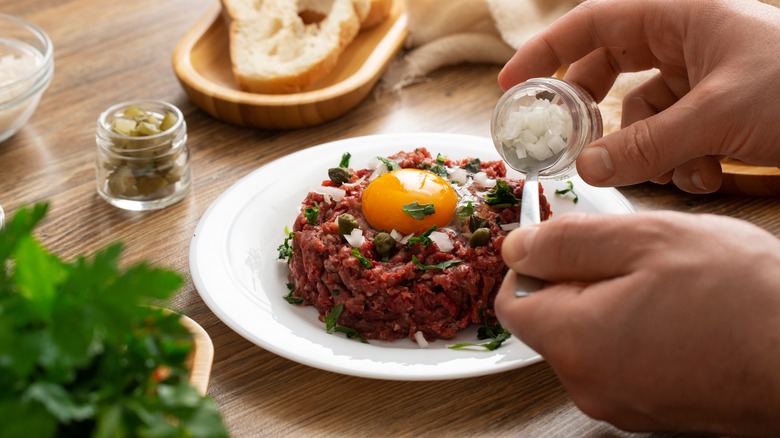The Important Safety Tip To Follow When Making Steak Tartare At Home
For home cooks, steak tartare can be a bit tricky to put together, as the dish doesn't actually involve any cooking at all. Traditionally, steak tartare features capers, alliums, anchovies, Worcestershire sauce, and, of course, minced raw beef with a raw egg yolk on top. It's the latter raw ingredients that give some pause. Even the USDA advises against serving or eating steak tartare due to the possibility of foodborne illnesses, recommending cooking beef instead at 160 degrees Fahrenheit to ensure food safety.
However, one can minimize the inherent risks of steak tartare by practicing proper safety. For one, you shouldn't buy your meat already minced or ground, as it can be a recipe for disaster. Butcher Jason Yang told Food & Wine, "It's important to start with a whole piece of meat rather than something ground, since properly handled whole muscles have a much lower risk of pathogens.'"
Processed meat, such as ground beef, is at a greater risk for bacteria exposure. When meat is processed through a grinder, a larger surface area is then exposed to potentially harmful microbes. So, when choosing the meat for your steak tartare, you should skip that pre-packed ground beef and go with whole cuts instead.
Best cuts of meat for steak tartare
When selecting meat for your steak tartare, you always want to choose beef of the highest quality. That means you probably should skip those supermarket chains and head for a local butcher, who can better advise you on the quality of the meat. While the USDA advises against consuming steak tartare, you can lower the risk of food poisoning by serving only fresh meat, per chef Ariane Daguin in HowStuffWorks. Fresh meat has a lower risk of bacterial infection, as long as your butcher practices proper hygiene. Never buy meat, much less meat that you plan to consume raw, from a butcher shop that looks less than sanitary.
As far as the best actual cut of meat, consider buying beef tenderloin. As the name suggests, this cut of meat originates from the loin of the cow, and is an incredibly tender piece of beef. Top-of-the-line steak cuts like the filet mignon come from this section of the cow as well. Since you'll be consuming the beef raw, even if it's minced, you'll want a piece of beef that's easy on the teeth. So, while those skirt steaks may be a better bargain, they will make for a poor steak tartare. Alternatively to beef tenderloin, you can also use top sirloin, which is a little less tender than a cut of beef tenderloin, but also less expensive.
How to safely prepare steak tartare
If you're not buying your meat already minced, then you'll have to do it yourself. Traditionally, the beef of steak tartare is minced by hand, which gives you greater control over the final product. However, you can use a meat grinder or food processor, but doing so comes with a big asterisk. Before using either, you must ensure that they are properly cleaned and sterilized, or else your beef may pick up bacteria during the process.
It's safer and ultimately probably more rewarding to mince your beef by hand. Before making steak tartare, stick your beef in the freezer for 15 minutes. This will help prepare the meat's texture, making it easier to slice up, since it will be firmer. Additionally, you wouldn't want to serve the tartare warm, as it's traditionally served cold. From there, you'll want to take a sharp knife and place your meat on a cutting board. Cut your meat into small cubes by creating diagonal strips in the meat. You'll want to be careful not to over-mince your meat. Otherwise, you'll be dealing with a mess that you won't be able to properly form.
Finally, mix in your ingredients and serve. It's important to serve your steak tartare right after assembly. If you leave your steak tartare uneaten for more than two hours, then it may no longer be safe to eat, per the USDA.


